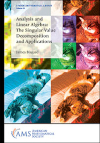- About MAA
- Membership
- MAA Publications
- Periodicals
- Blogs
- MAA Book Series
- MAA Press (an imprint of the AMS)
- MAA Notes
- MAA Reviews
- Mathematical Communication
- Information for Libraries
- Author Resources
- Advertise with MAA
- Meetings
- Competitions
- Programs
- Communities
- MAA Sections
- SIGMAA
- MAA Connect
- Students
- MAA Awards
- Awards Booklets
- Writing Awards
- Teaching Awards
- Service Awards
- Research Awards
- Lecture Awards
- Putnam Competition Individual and Team Winners
- D. E. Shaw Group AMC 8 Awards & Certificates
- Maryam Mirzakhani AMC 10 A Awards & Certificates
- Two Sigma AMC 10 B Awards & Certificates
- Jane Street AMC 12 A Awards & Certificates
- Akamai AMC 12 B Awards & Certificates
- High School Teachers
- News
You are here
Analysis and Linear Algebra: The Singular Value Decomposition and Applications

Buy Now:
Publisher:
AMS
Publication Date:
2019
Number of Pages:
217
Format:
Paperback
Series:
Student Mathematical Library
Price:
59.00
ISBN:
978-1-4704-6332-8
Category:
Textbook
The Basic Library List Committee suggests that undergraduate mathematics libraries consider this book for acquisition.
[Reviewed by , on ]
John Ross
02/27/2022
Analysis and Linear Algebra: The Singular Value Decomposition and Applications is a text that offers a strong undergraduate or early graduate student an overview of the theory and application of the Singular Value Decomposition (SVD). Along the way, it reminds the reader of the fundamental tools of analysis (such as inequalities, the use of compactness, and expressions of convergence), and examines how these tools can be used on objects and theories from linear algebra. The text’s author, James Bisgard, makes his case for this text as “a book that I wished I had had when I finished my undergraduate degree.” And in this, he is largely successful! It is clear that this is the appropriate audience for the book in terms of motivation, prerequisite knowledge, topics covered, and readability.
For motivation: The text’s first chapter provides ample and intuitive motivation for the rest of the text. A discussion of the “usefulness” of Linear Algebra is present here, as are brief statements of four motivating problems (the best subspace problem; the least-squares problem; the problem of approximating a matrix; and the orthogonal Procrustes problem). This chapter is easy to read, and I would readily recommend it to any Linear Algebra student who is wondering why the course is so useful.
For prerequisite knowledge: Readers are assumed to have a strong undergraduate background in real analysis and linear algebra. Some important definitions and tools from these courses are reviewed in Chapter 2, and this overview is well tailored to the rest of this text. However, I will admit that it is a bit short and to the point. A reader not fully grounded in analysis might struggle with this review, and I would recommend that a recent undergraduate student keep their old notes close at hand to use as a reference.
For reading outcomes: The text moves at a brisk but manageable pace. Chapter 3 uses the topics reviewed to expose the reader to core ideas present in SVD applications (such as orthogonality, projection onto closed sets, and so on). The chapter concludes with a brief overview of the SVD and brief explanations of solutions to the four problems already mentioned. Chapter 4 discusses the basics of Spectral Theory, while Chapters 5 and 6 return to the SVD and the four applications in much greater detail. The text concludes with a chapter on infinite-dimensional vector spaces, exposing what changes in this new setting.
For readability: The text is short, but well organized and the motivated student will find it very readable. There are an appropriate number of examples and exercises for the reader to work through but note that they are interspersed in the text (rather than lumped at the end of each chapter), and must be worked through as the reader advances. There are a handful of helpful pictures, and later chapters include a helpful “summary” section at the end.
Analysis and Linear Algebra: The Singular Value Decomposition and Applications provides a challenging but very enjoyable text that highlights how analysis and linear algebra fit together to be used in applications. I would recommend the first chapter as excellent reading for a linear algebra student in search of motivation; the first three chapters as a stand-alone reading course for an undergraduate wanting to learn about the SVD while brushing up on their analysis skills; and the full text as an independent study for to an advanced undergraduate who was strongly considering graduate school in either pure or applied mathematics.
John Ross is an assistant professor of mathematics at Southwestern University.
See the publisher's website.
- Log in to post comments




